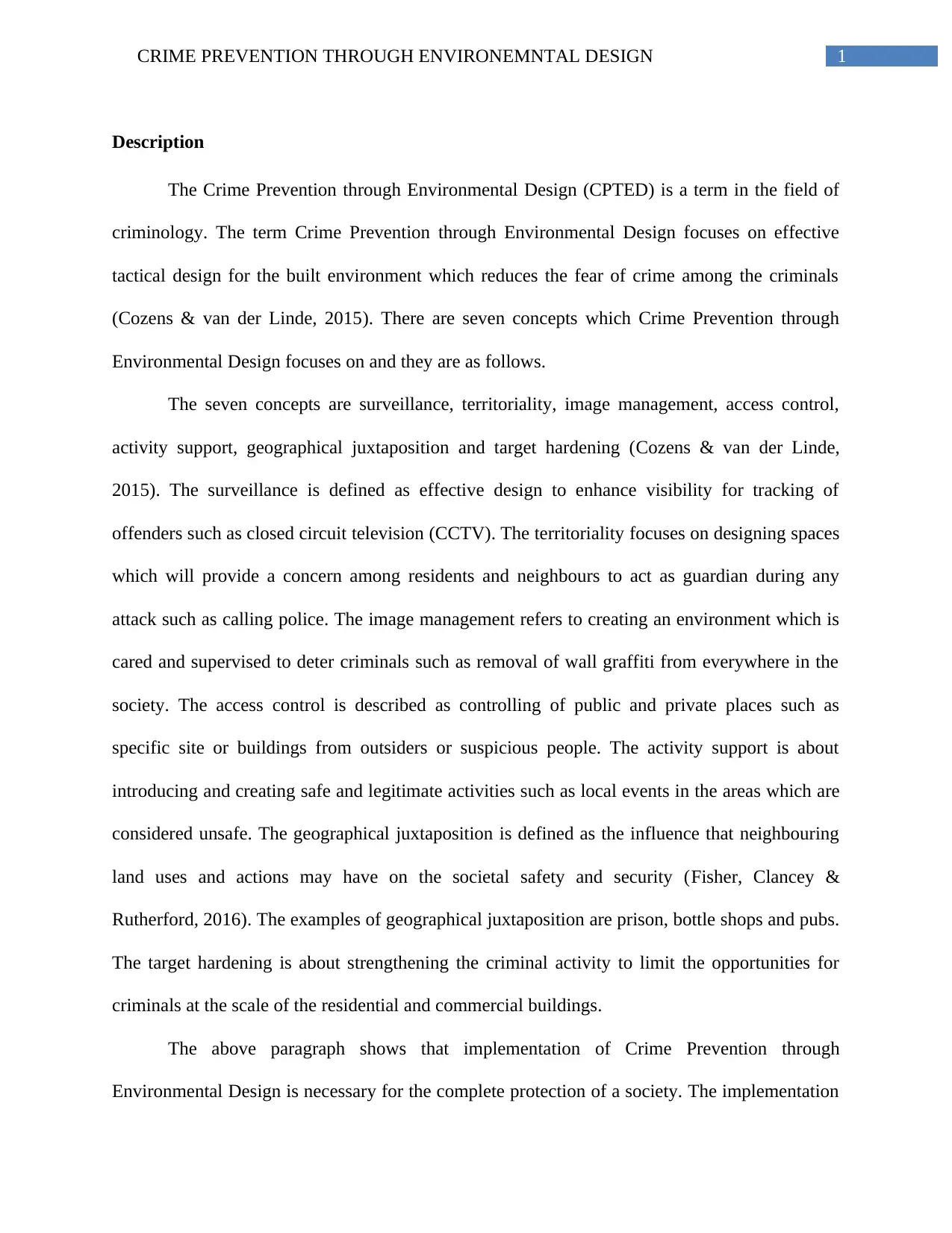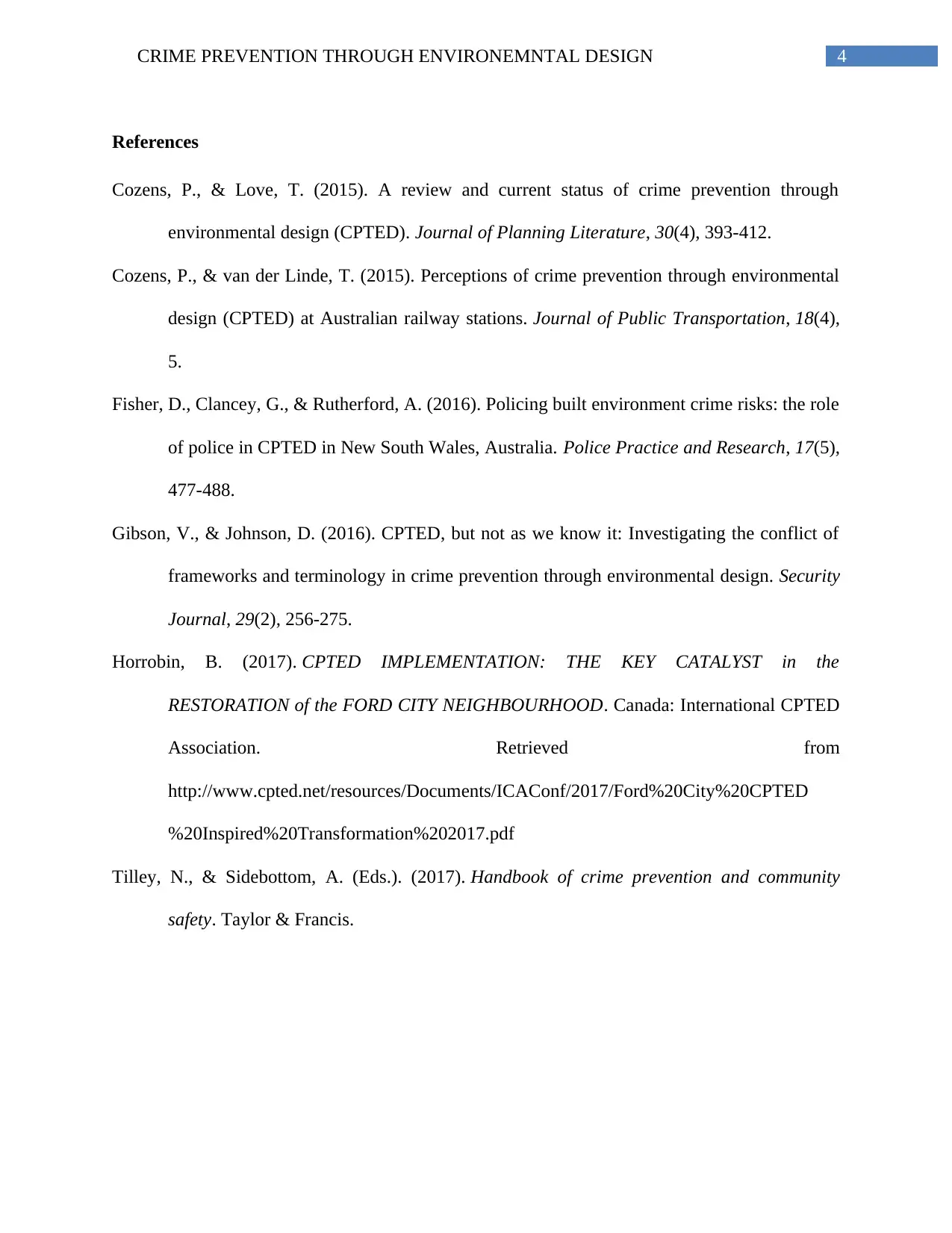Crime Prevention Through Environmental Design: Concepts and Strategies
VerifiedAdded on 2021/04/24
|5
|1137
|125
Essay
AI Summary
This essay delves into the concept of Crime Prevention Through Environmental Design (CPTED), a criminological approach that utilizes effective design of the built environment to reduce the fear of crime. The essay outlines the seven core concepts of CPTED: surveillance, territoriality, image management, access control, activity support, geographical juxtaposition, and target hardening, providing definitions and examples for each. It presents a case study of Ford City Neighbourhood, demonstrating the practical application of CPTED principles. Furthermore, the essay explores proven crime reduction policies and strategies, including alcohol policies, hot-spot policing, and intervention programs. It also addresses the criticisms of CPTED, such as its potential limitations and the issue of crime displacement. The essay concludes by emphasizing the importance of CPTED as an emerging concept in criminology, implemented by communities and governments worldwide.

Running head: CRIME PREVENTION THROUGH ENVIRONEMNTAL DESIGN
Crime Prevention through Environmental Design
Name of the Student
Name of the University
Author note
Crime Prevention through Environmental Design
Name of the Student
Name of the University
Author note
Paraphrase This Document
Need a fresh take? Get an instant paraphrase of this document with our AI Paraphraser

1CRIME PREVENTION THROUGH ENVIRONEMNTAL DESIGN
Description
The Crime Prevention through Environmental Design (CPTED) is a term in the field of
criminology. The term Crime Prevention through Environmental Design focuses on effective
tactical design for the built environment which reduces the fear of crime among the criminals
(Cozens & van der Linde, 2015). There are seven concepts which Crime Prevention through
Environmental Design focuses on and they are as follows.
The seven concepts are surveillance, territoriality, image management, access control,
activity support, geographical juxtaposition and target hardening (Cozens & van der Linde,
2015). The surveillance is defined as effective design to enhance visibility for tracking of
offenders such as closed circuit television (CCTV). The territoriality focuses on designing spaces
which will provide a concern among residents and neighbours to act as guardian during any
attack such as calling police. The image management refers to creating an environment which is
cared and supervised to deter criminals such as removal of wall graffiti from everywhere in the
society. The access control is described as controlling of public and private places such as
specific site or buildings from outsiders or suspicious people. The activity support is about
introducing and creating safe and legitimate activities such as local events in the areas which are
considered unsafe. The geographical juxtaposition is defined as the influence that neighbouring
land uses and actions may have on the societal safety and security (Fisher, Clancey &
Rutherford, 2016). The examples of geographical juxtaposition are prison, bottle shops and pubs.
The target hardening is about strengthening the criminal activity to limit the opportunities for
criminals at the scale of the residential and commercial buildings.
The above paragraph shows that implementation of Crime Prevention through
Environmental Design is necessary for the complete protection of a society. The implementation
Description
The Crime Prevention through Environmental Design (CPTED) is a term in the field of
criminology. The term Crime Prevention through Environmental Design focuses on effective
tactical design for the built environment which reduces the fear of crime among the criminals
(Cozens & van der Linde, 2015). There are seven concepts which Crime Prevention through
Environmental Design focuses on and they are as follows.
The seven concepts are surveillance, territoriality, image management, access control,
activity support, geographical juxtaposition and target hardening (Cozens & van der Linde,
2015). The surveillance is defined as effective design to enhance visibility for tracking of
offenders such as closed circuit television (CCTV). The territoriality focuses on designing spaces
which will provide a concern among residents and neighbours to act as guardian during any
attack such as calling police. The image management refers to creating an environment which is
cared and supervised to deter criminals such as removal of wall graffiti from everywhere in the
society. The access control is described as controlling of public and private places such as
specific site or buildings from outsiders or suspicious people. The activity support is about
introducing and creating safe and legitimate activities such as local events in the areas which are
considered unsafe. The geographical juxtaposition is defined as the influence that neighbouring
land uses and actions may have on the societal safety and security (Fisher, Clancey &
Rutherford, 2016). The examples of geographical juxtaposition are prison, bottle shops and pubs.
The target hardening is about strengthening the criminal activity to limit the opportunities for
criminals at the scale of the residential and commercial buildings.
The above paragraph shows that implementation of Crime Prevention through
Environmental Design is necessary for the complete protection of a society. The implementation

2CRIME PREVENTION THROUGH ENVIRONEMNTAL DESIGN
is specifically within the urbanized community. The implementation of Crime Prevention
through Environmental Design can be briefly described by an example of Ford City
Neighbourhood. According to Horrobin, (2017), the implementation of CPTED acted as a key
catalyst in the restoration of the Ford City Neighbourhood. The considered facts for renewing the
society are vacant property, safety dictates comfort level, positive action generation, promoting
positive actions and behaviours and self policy. These facts were looked upon to be improved
using CPTED implementation. The actions taken were changeover in address number, porch
light and target hardening along with enhancement to park, fests, picnics, clean sweep and day of
caring. However, the crimes are uninvited hence self and society protection is in individual’s
hand.
The Crime Prevention through Environmental Design is a best way to prevent and deter
crimes. There are various proven policies and strategies which can reduce crime and they are
given as follows. The first one is strict alcohol policy for people. This policy includes abolishing
alcohol outlets and higher tax on alcohol (Tilley & Sidebottom, 2017). The second one is hot-
spot policing in the areas which are vulnerable to crimes and this can be achieved by police
force. The third one is focused deterring policing for deterring community problems such as drug
dealing or violent behaviour. The fourth one is raising the grade or age for students dropping out
of school which shows that kids should be involved in schools for long time. The fifth one is
intervention programs for behavioural approach which shows that parental and community
interventions influence positive behaviour, deterring the negative behaviour. The sixth one is
fixing up abandoned and vacant buildings which results in rapid crimes. The fixing will
significantly drop the overall crimes related to vacant buildings.
is specifically within the urbanized community. The implementation of Crime Prevention
through Environmental Design can be briefly described by an example of Ford City
Neighbourhood. According to Horrobin, (2017), the implementation of CPTED acted as a key
catalyst in the restoration of the Ford City Neighbourhood. The considered facts for renewing the
society are vacant property, safety dictates comfort level, positive action generation, promoting
positive actions and behaviours and self policy. These facts were looked upon to be improved
using CPTED implementation. The actions taken were changeover in address number, porch
light and target hardening along with enhancement to park, fests, picnics, clean sweep and day of
caring. However, the crimes are uninvited hence self and society protection is in individual’s
hand.
The Crime Prevention through Environmental Design is a best way to prevent and deter
crimes. There are various proven policies and strategies which can reduce crime and they are
given as follows. The first one is strict alcohol policy for people. This policy includes abolishing
alcohol outlets and higher tax on alcohol (Tilley & Sidebottom, 2017). The second one is hot-
spot policing in the areas which are vulnerable to crimes and this can be achieved by police
force. The third one is focused deterring policing for deterring community problems such as drug
dealing or violent behaviour. The fourth one is raising the grade or age for students dropping out
of school which shows that kids should be involved in schools for long time. The fifth one is
intervention programs for behavioural approach which shows that parental and community
interventions influence positive behaviour, deterring the negative behaviour. The sixth one is
fixing up abandoned and vacant buildings which results in rapid crimes. The fixing will
significantly drop the overall crimes related to vacant buildings.
⊘ This is a preview!⊘
Do you want full access?
Subscribe today to unlock all pages.

Trusted by 1+ million students worldwide

3CRIME PREVENTION THROUGH ENVIRONEMNTAL DESIGN
The above paragraph shows how the effectiveness of Crime Prevention through
Environmental Design will impact the community. However, there are criticism related to Crime
Prevention through Environmental Design and they are discussed as follows. There are
arguments related to Crime Prevention through Environmental Design is that it does not reduces
crime effectively (Gibson & Johnson, 2016). The strategies and principles of Crime Prevention
through Environmental Design are not limited it can be out of the boundary also. There are
emerging crimes that are unknown and unidentified which can have huge negative impact. These
crimes require more advanced strategies, policies and principles to be developed to tackle the
offenders. The major criticism of Crime Prevention through Environmental Design is crime
displacement which means the displacement of crime beyond the CPTED evaluation boundaries
(Cozens & Love, 2015). The displacements are characterized as spatial, tactical, crime type,
crime target, perpetrator and temporal displacement.
Therefore, the above paragraphs show that Crime Prevention through Environmental
Design is an emerging concept in the field of criminology to prevent crime. This concept is
approached by community and government across the world.
The above paragraph shows how the effectiveness of Crime Prevention through
Environmental Design will impact the community. However, there are criticism related to Crime
Prevention through Environmental Design and they are discussed as follows. There are
arguments related to Crime Prevention through Environmental Design is that it does not reduces
crime effectively (Gibson & Johnson, 2016). The strategies and principles of Crime Prevention
through Environmental Design are not limited it can be out of the boundary also. There are
emerging crimes that are unknown and unidentified which can have huge negative impact. These
crimes require more advanced strategies, policies and principles to be developed to tackle the
offenders. The major criticism of Crime Prevention through Environmental Design is crime
displacement which means the displacement of crime beyond the CPTED evaluation boundaries
(Cozens & Love, 2015). The displacements are characterized as spatial, tactical, crime type,
crime target, perpetrator and temporal displacement.
Therefore, the above paragraphs show that Crime Prevention through Environmental
Design is an emerging concept in the field of criminology to prevent crime. This concept is
approached by community and government across the world.
Paraphrase This Document
Need a fresh take? Get an instant paraphrase of this document with our AI Paraphraser

4CRIME PREVENTION THROUGH ENVIRONEMNTAL DESIGN
References
Cozens, P., & Love, T. (2015). A review and current status of crime prevention through
environmental design (CPTED). Journal of Planning Literature, 30(4), 393-412.
Cozens, P., & van der Linde, T. (2015). Perceptions of crime prevention through environmental
design (CPTED) at Australian railway stations. Journal of Public Transportation, 18(4),
5.
Fisher, D., Clancey, G., & Rutherford, A. (2016). Policing built environment crime risks: the role
of police in CPTED in New South Wales, Australia. Police Practice and Research, 17(5),
477-488.
Gibson, V., & Johnson, D. (2016). CPTED, but not as we know it: Investigating the conflict of
frameworks and terminology in crime prevention through environmental design. Security
Journal, 29(2), 256-275.
Horrobin, B. (2017). CPTED IMPLEMENTATION: THE KEY CATALYST in the
RESTORATION of the FORD CITY NEIGHBOURHOOD. Canada: International CPTED
Association. Retrieved from
http://www.cpted.net/resources/Documents/ICAConf/2017/Ford%20City%20CPTED
%20Inspired%20Transformation%202017.pdf
Tilley, N., & Sidebottom, A. (Eds.). (2017). Handbook of crime prevention and community
safety. Taylor & Francis.
References
Cozens, P., & Love, T. (2015). A review and current status of crime prevention through
environmental design (CPTED). Journal of Planning Literature, 30(4), 393-412.
Cozens, P., & van der Linde, T. (2015). Perceptions of crime prevention through environmental
design (CPTED) at Australian railway stations. Journal of Public Transportation, 18(4),
5.
Fisher, D., Clancey, G., & Rutherford, A. (2016). Policing built environment crime risks: the role
of police in CPTED in New South Wales, Australia. Police Practice and Research, 17(5),
477-488.
Gibson, V., & Johnson, D. (2016). CPTED, but not as we know it: Investigating the conflict of
frameworks and terminology in crime prevention through environmental design. Security
Journal, 29(2), 256-275.
Horrobin, B. (2017). CPTED IMPLEMENTATION: THE KEY CATALYST in the
RESTORATION of the FORD CITY NEIGHBOURHOOD. Canada: International CPTED
Association. Retrieved from
http://www.cpted.net/resources/Documents/ICAConf/2017/Ford%20City%20CPTED
%20Inspired%20Transformation%202017.pdf
Tilley, N., & Sidebottom, A. (Eds.). (2017). Handbook of crime prevention and community
safety. Taylor & Francis.
1 out of 5
Your All-in-One AI-Powered Toolkit for Academic Success.
+13062052269
info@desklib.com
Available 24*7 on WhatsApp / Email
![[object Object]](/_next/static/media/star-bottom.7253800d.svg)
Unlock your academic potential
Copyright © 2020–2025 A2Z Services. All Rights Reserved. Developed and managed by ZUCOL.
